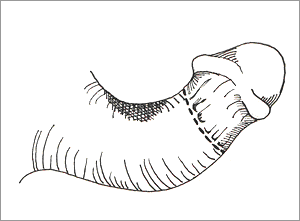What is Peyronie’s Disease and Are There Any Safe
and Effective Alternatives to Straightening the Penis
Other Then Embarrassing and Expensive Surgery?
Peyronie’s disease (PD) is the hardening of tissue (fibrosis) in the penis. The disease is so called as it was named after François de la Peyronie, surgeon to King Louis XV of France) who first described Peyronie’s disease in 1743.
However, the problem was noted in print as early as 1687. Early writers classified it as a form of impotence, now called erectile dysfunction (ED).
How common is the problem?
Estimates of the prevalence of Peyronie’s disease range from less than 1 percent to 23 percent. Another survey indicated that about one in every hundred men, develop this disease, although definite numbers are hard to determine as many men do not recognize the problem or seek medical attention as the symptoms are mild.
Who is at risk?
Age: PD usually affects men aged between 45 – 60 years, but can happen at any age.
Family history: Men with a family history of Peyronie’s disease are more likely to develop this problem.
Race: It also appears to be more common in white men with Northern European ancestry. It is uncommon in African- American men and rare in Asian men.
What causes Peyronie’s disease?
It is not clear exactly what causes Peyronie’s disease, but it is thought to involve trauma, genetics or auto-immune factors or a combination of these factors.
Heredity: Peyronie’s disease runs in the families, which suggests that genetic factors might make a man vulnerable to the disease. In fact, men having blood relatives with this problem are more likely to develop PD, which suggests that there are genetic factors involved.
Trauma or injury: Many researchers believe the plaque of Peyronie’s disease develops following trauma, such as hitting or bending that causes localized bleeding inside the penis. Sometimes Peyronie’s disease follows an obvious injury to the penis, such as a sporting incident, motor vehicle accident or pelvic or urologic surgery. Injury can also be caused, even without realizing, during sexual activity, when the penis is pushed or bent against the partner’s pelvic bone.
Autoimmunity: The body cells responsible for maintaining immunity of the body against foreign invaders (e.g. virus, bacteria) begin to destroy the body itself and result in several changes in various body parts including penis.
It should be noted that Peyronie’s disease is not contagious and is not known to be caused by any transmittable disease.
How does Peyronie’s disease develop?
In Peyronie’s disease, a lump or scar tissue (plaque) is formed on the lining of the erectile tissue which holds much of the blood in the penis during erection. The hardened area or plaque prevents normal stretching and can impact on the size and shape of the erect penis.
How would you know if you have Peyronie’s disease (Signs & symptoms)?
Peyronie’s disease (PD) begins as a small swelling or inflammation which hardens into a lump on the upper or lower side of the penis. It usually develops over time but sometimes appears very quickly. It can be painful, reduce flexibility, and in some cases shorten or create a bend or hour-glass effect in the penis when erect. Some men find it difficult to get or keep erections, or the penis only becomes rigid up to the area of the scar and remains flaccid past that point.
How is Peyronie’s disease diagnosed?
Doctors can usually diagnose Peyronie’s disease based on a physical examination. The plaque can be felt when the penis is limp. Full evaluation, however, may require examination during erection to determine the severity of the deformity. The erection may be induced by injecting medicine into the penis or through self-stimulation. Some patients may eliminate the need to induce an erection in the doctor’s office by taking a digital or Polaroid picture at home. The examination may include an ultrasound scan of the penis.
Complications of Peyronie’s disease
When the penis is bent or bumped, the lining to the shaft is damaged. Small blood vessels can rupture or burst and proper blood flow is interrupted.
Erectile dysfunction: Peyronie’s disease can also be associated with ED, the inability to achieve or sustain an erection firm enough for intercourse.
Other complications: As the lumps formed are benign or noncancerous, it is not life threatening. However, it can prevent sexual intercourse and the pain and impact on sex life, can lead to distress, anxiety and lower self-esteem.
How is Peyronie’s disease treated?
Men with Peyronie’s disease usually seek medical attention because of the painful erections, penile deformity, or difficulty with intercourse. Treatments for Peyronie’s disease include surgical and non-surgical options such as oral medicines, injections, devices (stretchers).
Surgery
If the curvature or pain continues after 12 months, surgery is generally recommended, particularly if the ability to have sexual intercourse is affected. While surgery can produce positive results, frequent complications can occur, and because many of the effects of Peyronie’s disease (for example, shortening of the penis are not usually corrected by surgery), most doctors prefer to perform surgery only on the small number of men with curvature severe enough to prevent sexual intercourse. For the same reason, medical experts suggest waiting 1 year or longer before attempting to correct Peyronie’s disease surgically.
Alternatives to surgery (Non-surgical treatment)
As the Penile curvature correction surgery is becoming unpopular among doctors and patients alike, partly due to its high cost and high health risks involved, many medical therapies have been tried over a period of time. These include vitamin E in tablet or cream form, potassium aminobenzoate (a chemical that belongs to the Vitamin B group and is used to break down hard, fibrous skin), medicines (colchicines and tamoxifen), extracorporeal shock wave therapy, radiation therapy, interferons and quite recently, the use of external penis stretchers.
Can external penis stretcher reduce peyronie’s penile curvature?
In a very interesting yet promising study presented in the 2nd European Congress of Andrology (September 2002), the efficacy of mechanical penile stretching (PS) to reduce penile deformity during erection was tested. The study was done in Italy on ten patients affected by Peyronie’s disease, apparently unchanged at least for the latest 3 months and with penile curvature during erection (PEC).
Measurements were performed before and after daily home penile stretching application (at least four hours / day) for 3 to 6 months. As a result, penile curvature during erection was significantly and successfully decreased after 3 months. Also, the treatment was well tolerated (no severe complication and no drop out occurred). The results suggested a promising use of penile stretchers in selected Peyronie’s patients affected by penile curvature without erectile dysfunction.
Based on the above study and many other observations, some experts now recommend the use of penile stretchers as the only effective non-surgical solution for the treatment of Peyronie’s Disease and penile curvatures. The penis stretchers work on the same simple principles of traction as we often see used by native people around the world, when elongating, enlarging or stretching some of parts of their bodies (i.e. necks and ears) as their customs require.
Furthermore, unlike medications and surgery, they are virtually free from any side effects and are much cheap on the long run.
In short, Peyronie’s disease is a common but treatable male disorder that can be managed in several ways. While surgery is an option, it is often associated with a high risk of complications, more costs and other problems.
Penis stretching devices, on the other hand, provide men with a self-administered cure for Peyronie’s disease. These products effectively use traction to promote a significant reduction in penile curvature, while also lengthening the penis and leaving no scars.






